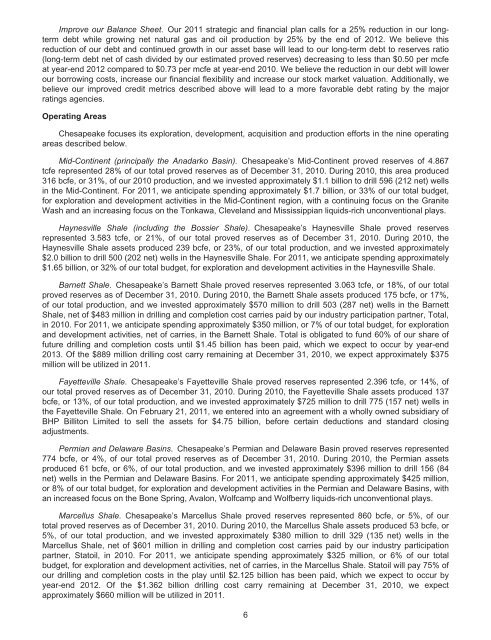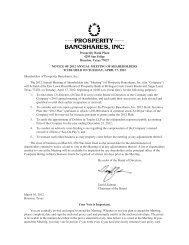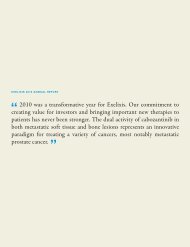6 5 - RR DONNELLEY FINANCIAL - External Home Login
6 5 - RR DONNELLEY FINANCIAL - External Home Login
6 5 - RR DONNELLEY FINANCIAL - External Home Login
You also want an ePaper? Increase the reach of your titles
YUMPU automatically turns print PDFs into web optimized ePapers that Google loves.
Improve our Balance Sheet. Our 2011 strategic and financial plan calls for a 25% reduction in our longterm<br />
debt while growing net natural gas and oil production by 25% by the end of 2012. We believe this<br />
reduction of our debt and continued growth in our asset base will lead to our long-term debt to reserves ratio<br />
(long-term debt net of cash divided by our estimated proved reserves) decreasing to less than $0.50 per mcfe<br />
at year-end 2012 compared to $0.73 per mcfe at year-end 2010. We believe the reduction in our debt will lower<br />
our borrowing costs, increase our financial flexibility and increase our stock market valuation. Additionally, we<br />
believe our improved credit metrics described above will lead to a more favorable debt rating by the major<br />
ratings agencies.<br />
Operating Areas<br />
Chesapeake focuses its exploration, development, acquisition and production efforts in the nine operating<br />
areas described below.<br />
Mid-Continent (principally the Anadarko Basin). Chesapeake’s Mid-Continent proved reserves of 4.867<br />
tcfe represented 28% of our total proved reserves as of December 31, 2010. During 2010, this area produced<br />
316 bcfe, or 31%, of our 2010 production, and we invested approximately $1.1 billion to drill 596 (212 net) wells<br />
in the Mid-Continent. For 2011, we anticipate spending approximately $1.7 billion, or 33% of our total budget,<br />
for exploration and development activities in the Mid-Continent region, with a continuing focus on the Granite<br />
Wash and an increasing focus on the Tonkawa, Cleveland and Mississippian liquids-rich unconventional plays.<br />
Haynesville Shale (including the Bossier Shale). Chesapeake’s Haynesville Shale proved reserves<br />
represented 3.583 tcfe, or 21%, of our total proved reserves as of December 31, 2010. During 2010, the<br />
Haynesville Shale assets produced 239 bcfe, or 23%, of our total production, and we invested approximately<br />
$2.0 billion to drill 500 (202 net) wells in the Haynesville Shale. For 2011, we anticipate spending approximately<br />
$1.65 billion, or 32% of our total budget, for exploration and development activities in the Haynesville Shale.<br />
Barnett Shale. Chesapeake’s Barnett Shale proved reserves represented 3.063 tcfe, or 18%, of our total<br />
proved reserves as of December 31, 2010. During 2010, the Barnett Shale assets produced 175 bcfe, or 17%,<br />
of our total production, and we invested approximately $570 million to drill 503 (287 net) wells in the Barnett<br />
Shale, net of $483 million in drilling and completion cost carries paid by our industry participation partner, Total,<br />
in 2010. For 2011, we anticipate spending approximately $350 million, or 7% of our total budget, for exploration<br />
and development activities, net of carries, in the Barnett Shale. Total is obligated to fund 60% of our share of<br />
future drilling and completion costs until $1.45 billion has been paid, which we expect to occur by year-end<br />
2013. Of the $889 million drilling cost carry remaining at December 31, 2010, we expect approximately $375<br />
million will be utilized in 2011.<br />
Fayetteville Shale. Chesapeake’s Fayetteville Shale proved reserves represented 2.396 tcfe, or 14%, of<br />
our total proved reserves as of December 31, 2010. During 2010, the Fayetteville Shale assets produced 137<br />
bcfe, or 13%, of our total production, and we invested approximately $725 million to drill 775 (157 net) wells in<br />
the Fayetteville Shale. On February 21, 2011, we entered into an agreement with a wholly owned subsidiary of<br />
BHP Billiton Limited to sell the assets for $4.75 billion, before certain deductions and standard closing<br />
adjustments.<br />
Permian and Delaware Basins. Chesapeake’s Permian and Delaware Basin proved reserves represented<br />
774 bcfe, or 4%, of our total proved reserves as of December 31, 2010. During 2010, the Permian assets<br />
produced 61 bcfe, or 6%, of our total production, and we invested approximately $396 million to drill 156 (84<br />
net) wells in the Permian and Delaware Basins. For 2011, we anticipate spending approximately $425 million,<br />
or 8% of our total budget, for exploration and development activities in the Permian and Delaware Basins, with<br />
an increased focus on the Bone Spring, Avalon, Wolfcamp and Wolfberry liquids-rich unconventional plays.<br />
Marcellus Shale. Chesapeake’s Marcellus Shale proved reserves represented 860 bcfe, or 5%, of our<br />
total proved reserves as of December 31, 2010. During 2010, the Marcellus Shale assets produced 53 bcfe, or<br />
5%, of our total production, and we invested approximately $380 million to drill 329 (135 net) wells in the<br />
Marcellus Shale, net of $601 million in drilling and completion cost carries paid by our industry participation<br />
partner, Statoil, in 2010. For 2011, we anticipate spending approximately $325 million, or 6% of our total<br />
budget, for exploration and development activities, net of carries, in the Marcellus Shale. Statoil will pay 75% of<br />
our drilling and completion costs in the play until $2.125 billion has been paid, which we expect to occur by<br />
year-end 2012. Of the $1.362 billion drilling cost carry remaining at December 31, 2010, we expect<br />
approximately $660 million will be utilized in 2011.<br />
6











